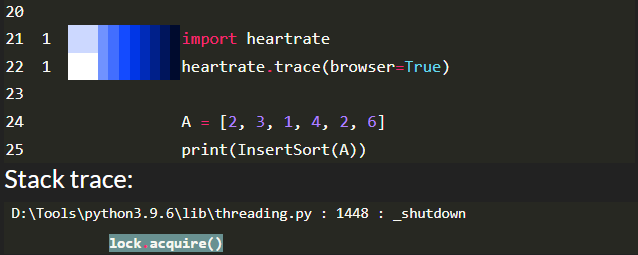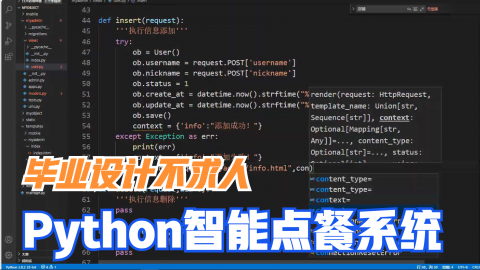性能检测分析方法 - 时间、空间衡量方法
Python 自带模块
import time
点击查看代码
# 仅仅是示范 time 模块的用法,此段不能直接运行,运行请看测试项目源码
import time
def measure_runtime(func):
time_start = time.time()
func()
time_end = time.time()
print(time_end - time_start)
measure_runtime(lambda :out_Sorted_list("插入排序","InsertSort"))
import timeit
点击查看代码
# 仅仅是示范 timeit 模块的用法,此段不能直接运行,运行请看测试项目源码
# 运行五次插入排序函数得到使用时间
temp = timeit.timeit(lambda : out_Sorted_list("插入排序","InsertSort"),number=5)
print(temp)
第三方模块
pip install memory_profiler
♠ 能够监视进程、了解内存使用等情况
点击查看代码
from memory_profiler import profile
@profile
def get_Unordered_list():
A = [2, 3, 1, 4, 2, 6]
print("排序前列表:",A)
return A
get_Unordered_list()
运行后
点击查看运行结果
Line # Mem usage Increment Occurrences Line Contents
=============================================================
39 34.4 MiB 34.4 MiB 1 @profile
40 def get_Unordered_list():
41 34.4 MiB 0.0 MiB 1 A = [2, 3, 1, 4, 2, 6]
42 34.4 MiB 0.0 MiB 1 print("排序前列表:",A)
43 34.4 MiB 0.0 MiB 1 return A
pip install line_profiler
♣ 代码行运行时间检测
点击查看代码
from line_profiler import LineProfiler
lp = LineProfiler()
lp_wrap = lp(get_Unordered_list)
lp_wrap()
lp.print_stats()
运行后
点击查看代码
排序前列表: [2, 3, 1, 4, 2, 6]
Timer unit: 1e-07 s
Total time: 2.43e-05 s
File: E:/Python_Projects/Test_Env/Test_Project/算法导论_第三版/Chapter_2_算法基础.py
Function: get_Unordered_list at line 40
Line # Hits Time Per Hit % Time Line Contents
==============================================================
40 def get_Unordered_list():
41 1 6.0 6.0 2.5 A = [2, 3, 1, 4, 2, 6]
42 1 217.0 217.0 89.3 print("排序前列表:",A)
43 1 20.0 20.0 8.2 return A
pip install heartrate
♥ 可视化检测工具
点击查看代码
import heartrate
heartrate.trace(browser=True)
def InsertSort(noSortedlist):
"""
插入排序:对于少量元素的排序n
输入:输入一个未排序数组/列表n
输出:输出一个从小到大排序好的数组/列表n
For example: 手中扑克牌排序
"""
for j in range(1,len(noSortedlist)):
key = noSortedlist[j]
i = j-1
while i >= 0 and noSortedlist[i] > key:
noSortedlist[i+1] = noSortedlist[i]
i = i -1
noSortedlist[i+1] = key
return noSortedlist
import heartrate
heartrate.trace(browser=True)
A = [2, 3, 1, 4, 2, 6]
print(InsertSort(A))
运行后

测试项目源码
点击查看项目源码
""" 算法基础 """
# In[]
""" 2.1 插入排序 """
from memory_profiler import profile
# 输入是一个序列 A =[2,3,1,4,2,6]
def InsertSort(noSortedlist):
"""
插入排序:对于少量元素的排序n
输入:输入一个未排序数组/列表n
输出:输出一个从小到大排序好的数组/列表n
For example: 手中扑克牌排序
"""
for j in range(1,len(noSortedlist)):
key = noSortedlist[j]
i = j-1
while i >= 0 and noSortedlist[i] > key:
noSortedlist[i+1] = noSortedlist[i]
i = i -1
noSortedlist[i+1] = key
return noSortedlist
@profile
def get_Unordered_list():
A = [2, 3, 1, 4, 2, 6]
print("排序前列表:",A)
return A
def out_Sorted_list(name,methodName):
method = eval(str(methodName))
sorted_list = method(get_Unordered_list())
print(f"使用{name}排序后列表:",sorted_list)
def measure_runtime(func):
time_start = time.time()
func()
time_end = time.time()
print(time_end - time_start)
if __name__ == '__main__':
import timeit
import time
# 衡量插入排序
print(timeit.timeit(lambda : out_Sorted_list("插入排序","InsertSort"),number=5))
measure_runtime(lambda :out_Sorted_list("插入排序","InsertSort"))
内容来源于网络如有侵权请私信删除
文章来源: 博客园
- 还没有人评论,欢迎说说您的想法!





 客服
客服


